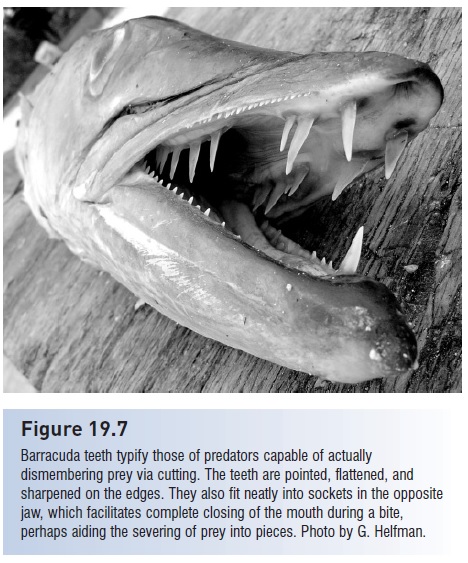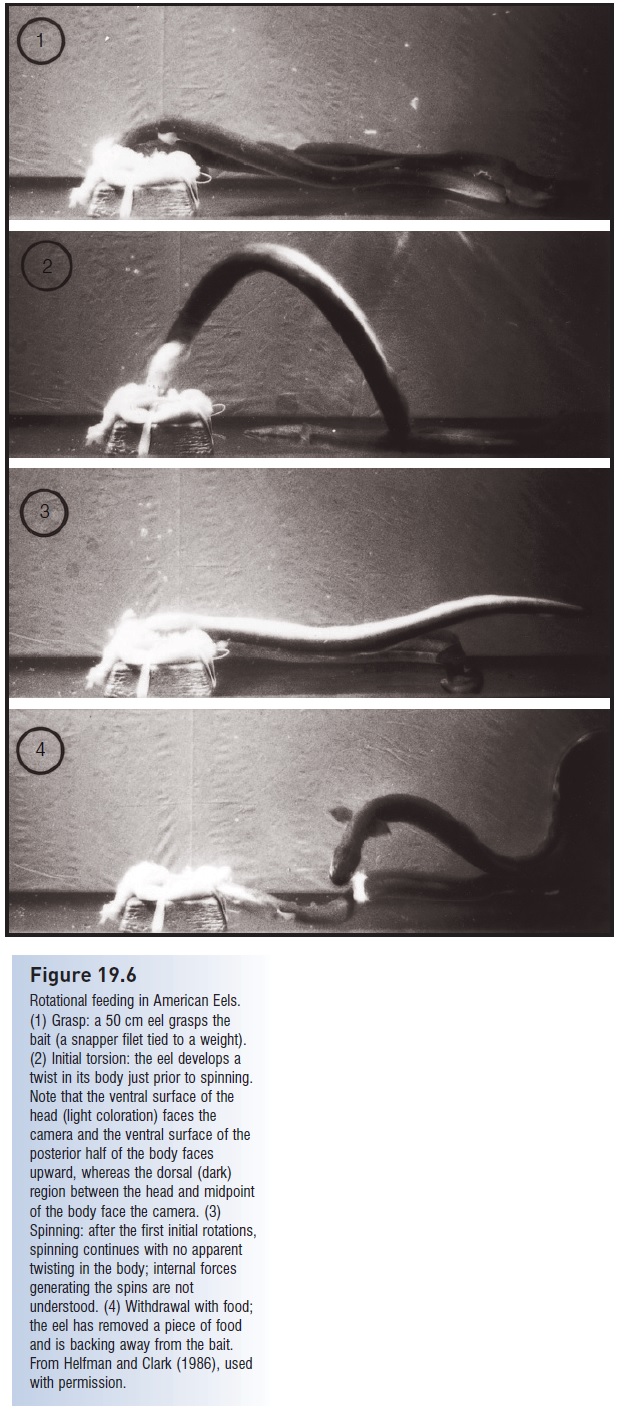Chapter: The Diversity of Fishes: Biology, Evolution, and Ecology: Fishes as predators
Handling - Fishes as predators
Handling
Handling includes any postcapture manipulation required to subdue prey and make it ingestible and digestible. Fishes that feed on hard-bodied prey or on prey with primary external defenses such as spines, shells, bony scales, or toxic skins must usually spend time and energy in handling, as do scavengers that feed on prey too large to be swallowed whole.
Assuming prey are small enough to be swallowed and possess no exceptional defenses such as bony armor, poisonous spines, or toxic skin secretions, piscivores face one major handling task. The prey must be manipulated into a head-first orientation for swallowing (Reimchen 1991). Such manipulation is less important with nonspiny fishes such as clupeiforms, most ostariophysans, and salmoniforms, but even soft-rayed fishes can become lodged in the throat if they are large and swallowed tail-first. Head-first swallowing facilitates depression of the dorsal, anal, and pelvic fins, all of which can anchor themselves in the predator’s mouth or throat. Additionally, head-first swallowing reduces the likelihood of escape from the mouth since few non-eel-like fishes can swim backwards effectively. Positioning is accomplished by jaw and head movements. As many predators will attack fishes as long as themselves (or even longer in the case of many deepsea species), it is not unusual to observe a piscivore swimming with the tail or more of a prey fish protruding from its mouth. Such a large meal obviously represents an energetic bonanza, but is obtained at a potential cost if it hampers the predator’s ability to escape its predators. On occasion, one finds a dead predator floating with a large, dead prey fish protruding from its mouth, testimony to the importance of gape limitation and the evolution of an ability to accurately estimate the size of potential prey.
Preparation for swallowing is accomplished by teeth. Dentition type is a reliable indicator of both prey type and foraging tactics (see Dentition). Piscivores either hold their prey with large, sharp-pointed teeth or numerous needlelike teeth, or they chop prey up with flat, bladelike teeth (Fig. 19.7). These teeth may be in the marginal jaws or on the palate and tongue. Insect feeders generally have moderately stout, conical, recurved teeth, again marginally or as part of the pharyngeal apparatus. Most fishes that feed on mollusks or echinoderms crush the shell in the mouth, using molarlike teeth. Fishes with parrotlike beaks (parrotfishes, puffers) feed on tough sponges, algae, or coral, with supplemental crushing in a pharyngeal mill in parrotfishes. Gill rakers also characterize different foraging types, functioning either for retention of prey or as mechanical barriers to escape. Numerous, long, thin, gill rakers filter out small plankters as water passes through the mouth and out the opercular openings; gill raker spacing is usually directly related to prey size. Fish eaters have harder, stouter, more widely spaced rakers that prevent escape through the gill opening (e.g., seabasses, Largemouth Bass).

Figure 19.7
Barracuda teeth typify those of predators capable of actually dismembering prey via cutting. The teeth are pointed, flattened, and sharpened on the edges. They also fit neatly into sockets in the opposite jaw, which facilitates complete closing of the mouth during a bite, perhaps aiding the severing of prey into pieces. Photo by G. Helfman.
Some armored and otherwise defended prey require special handling tactics. Sea urchins are abundant and their internal organs are edible. However, the defensive spines must first be removed. Special methods for despining urchins include plucking individual spines off to expose the outer test (triggerfishes, Balistidae), blowing water jets to roll the urchin over, exposing the relatively spineless ventral surface (triggerfishes), or picking the urchin up by a spine and bashing it open on a rock (wrasses, Labridae). Wrasses also smash crabs against rocks to remove a leg or claw, which they then crush in their pharyngeal jaws (Wainwright 1988a). Some predators apparently wash distasteful substances off the surface of prey by manipulating them in the mouth. For example, a Largemouth Bass fed whirligig beetles that secrete noxious chemicals or meal worms dipped in distasteful chemicals will repeatedly slosh the worm in its mouth and spit it out several times before
finally swallowing it. Undipped worms are simply swallowed (T. Eisner, pers. comm.).

Figure 19.6
Rotational feeding in American Eels. (1) Grasp: a 50 cm eel grasps the bait (a snapper filet tied to a weight). (2) Initial torsion: the eel develops a twist in its body just prior to spinning. Note that the ventral surface of the head (light coloration) faces the camera and the ventral surface of the posterior half of the body faces upward, whereas the dorsal (dark) region between the head and midpoint of the body face the camera. (3) Spinning: after the first initial rotations, spinning continues with no apparent twisting in the body; internal forces generating the spins are not understood. (4) Withdrawal with food; the eel has removed a piece of food and is backing away from the bait. From Helfman and Clark (1986), used with permission.
Final handling occurs in the stomach and intestines. Chemical breakdown via acids and enzymes is the rule, supplemented by mechanical grinding in the gizzards of Gizzard Shad (Clupeidae) and mullets (Mugilidae), and the gizzardlike stomach of Milkfish (Chanidae), some characoids (Prochilodontidae, Curimatidae), butterfishes (Stromateidae), and surgeonfishes (Acanthuridae). Deepsea fishes such as black swallowers (Chiasmodontidae) have highly distensible stomachs that expand to accommodate prey considerably longer than the body of the predator (see The deep sea).
Related Topics